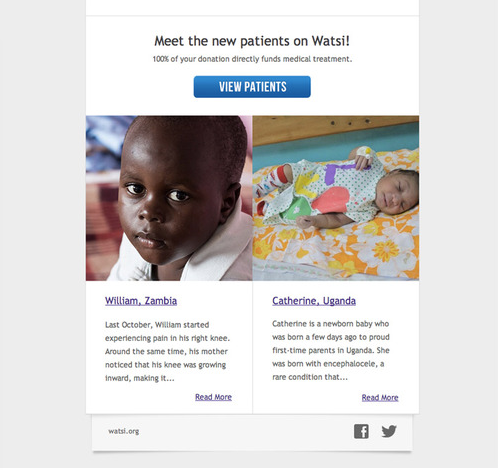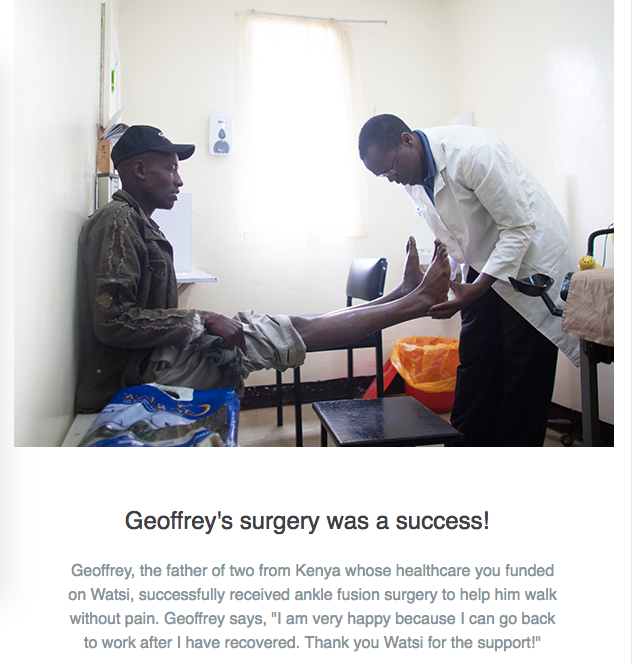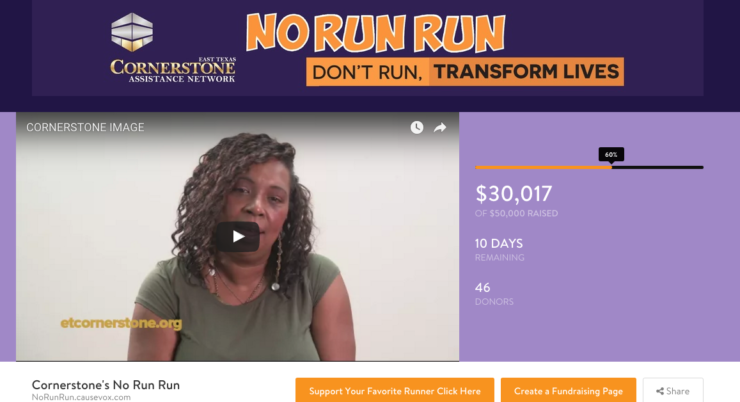You’ve heard a lot about how fundraising emails can help your nonprofit or charity connect with donors and ensure a steady stream of donations.
But with the average email user sending and/or receiving over 205 emails every single day, what makes a good email stand out? How do you entice your email recipients to not just open, but read your emails?
Thankfully, there are some nonprofits out there, not just succeeding, but breaking the mold with their fundraising email campaigns. Take Watsi, for example. This relatively new nonprofit has quickly turned heads in the nonprofit and business worlds because of its strong fundraising email strategy.
“There are some nonprofits out there breaking the mold with their fundraising email campaigns…” tweet this
Let’s take a look at some of the ways Watsi has used fundraising emails to acquire over 1,300 recurring donors and discuss how you can incorporate some of the same practices into your own fundraising email strategy.
1. Ask Donors What They Want
When developing their recurring giving program, Watsi focused on what their donors wanted. They surveyed their donors to find out what they liked most about the cause and what fueled them to continue giving. As they began creating the monthly giving “brand”, the Watsi team infused information obtained directly from this testing into their fundraising email strategy. The result? Today, around 20% of Watsi’s monthly income comes from these recurring donors.
What can you do? Test, test, and test again! Segment your email audience and send out emails using different strategies like personalized vs. generic, branding similar to website vs. new style, using first name vs. using first and last. And don’t stop! Continue improving on your fundraising email strategy based on donor response and feedback.

2. Meet Donors Where They Are
Some of your donors will donate simply because they’re asked, while others will need to be nurtured. Watsi found that there wasn’t a “one-size fits all” strategy to acquire new monthly donors.
“Some of your donors will donate simply because they’re asked, while others will need to be nurtured…” tweet this
Instead, they had to cater to the needs, desires, and points of motivation for a variety of people. By analyzing how donors came to them, Wasti was able to target communications based on how donors were acquired.
What can you do? Keep tabs on your donor’s trigger points and figure out what in that email motivated your donor to give? Is it after clicking through a story? Is it because of a powerful photo you posted? Then, follow-up with that donor using similar types of correspondence to keep your donors excited (and motivated) to give.
3. Communicate Results
Does the novelty of giving wear off for donors that give month after month? It’s possible. But it’s definitely not ideal. Watsi found that by communicating regularly about the people they were supporting, donors remained energized about the cause. Every month, Watsi features the story of a client impacted by donor gifts.

What can you do? Don’t assume that too much news is bad news. After all, if your donor is choosing to give on a recurring basis, they are doing so because they believe in your cause. Try connecting your donor to a person or group that was positively impacted by their gift. By adding a human element to your fundraising email strategy, you’ll keep your donor in the loop and reinforce that their gift matters.
4. Donors Need To Feel A Part of the Cause
Another unique fundraising email strategy that Watsi used was to give monthly donors a number. Wait! A number? Isn’t that informal? Yes, but hear me out.
Consider how impactful it is to be one of a greater number of individuals working for something important. That’s the idea behind this strategy. Numbers gave the air of exclusivity and urgency. Watsi also added in a gift match for the first 1,000 monthly donors, which was further motivation for donors to get involved immediately.
What can you do? Tout your numbers! Many people donate because they want to feel a part of something bigger than themselves. When a donor sees that they are monthly donor 101 of 1,000, they know that they are part of a team working toward good.
“Many people donate because they want to feel a part of something bigger than themselves…” tweet this

And, if you can secure a match from a major donor, corporation, or foundation- even better! Focus on the team effort behind your work and your donor’s role within the group.
5. Customize The Experience
After lots of testing, Watsi found that simple, personalized, and casual plain-text emails received higher response than traditional HTML fundraising emails. So they stuck with it and continue to see high engagement rates with this tactic.

What can you do? Keep it simple, especially when you’re trying to turn a one-time donor into an ongoing donor. Address your donor by name, thank them for their support, and give them “backstage” access to your recurring giving program.
6. Focus On The Thank You
Watsi doesn’t skimp on their thank-yous. In fact, they continue to give monthly donors a special, personalized email every month to express appreciation. These emails feature a patient helped by their gift. In the donor’s eyes, it’s a moving and happy moment they can look forward to on a regular basis.
But, they didn’t stop there. Watsi also wanted to give their donors what they called “shock and awe”- a surprise when they least expected it. In this case, they created and mailed a printed book of photographs of their work around the world.
What can you do? Throw your generic thank you email out the window. Instead, give your donors something they can take with them. While it doesn’t necessarily have to be a written thank you letter, at the very least personalize your message and give them a behind-the-scenes look at what their donation went toward.
“Throw your generic thank you email out the window. Instead, give donors something they can take with them…” tweet this
Take a few notes from Watsi and develop a fundraising email strategy that works for your donors. Fine-tune your fundraising emails by:
- Figuring out what donors want from your cause
- Determining what motivates your donors to give
- Communicating results often
- Including your donors in on the “team effort”
- Customizing the donor experience
- Thanking your donors authentically
Loyal, retained donors provide your nonprofit or charity a steady and reliable income, leaving you time to recruit new donors to the cause.




